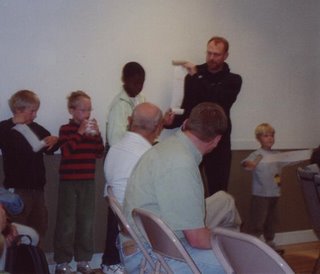I taught Firstday School on Sunday. It was an ambitious lesson covering two parables from Luke, Jesus' entry into Jerusalem, the Last Supper, Quaker business process, and an activity to draw menu choices for the kingdom feast. It somehow worked, except I should have skipped the presentation to the full meeting. The lesson scheme is posted below.
And this was after giving vocal ministry while holding a cordless drill in its case...
cubbie had asked to borrow it, and so I had it in my backpack. It felt right to use it as part of the metaphor about building community, sometimes literally by building houses, sometimes by taking meals to parents who are staying in the hospital with their 18-month-old son while he gets a long list of tests for an unknown ailment...
No wonder I'm tired even two days later.
- - - - -
A Firstday School Lesson Given During Lent 2007Introductions: say your name and your favorite season
Objectives:
· To learn about the holiday of Easter and the life of Jesus
· To practice how Quakers make decisions
· To do an activity that we decide on as a group
Strategies:
· Read two parables: the lost sheep (Lk 15:1-7) and the lost coin (Lk 15:8-10).
o Lesson: God loves all of us and wants us to find God
· Read about Jesus’s entry into Jerusalem (Lk 19:35-40) and cleansing of the temple (Lk 19:45)
o God’s kingdom is here and now if we can see it. Even the stones will shout aloud! (Some people say they find God in nature; could that be a part of what that means?)
o Jesus was also making the point that the people of Israel would not get their freedom back from the Romans by attacking the Romans with armies. They had to do it by inviting God into their lives, by acting out of love toward their enemies.
o That provoked the political and religious leaders, and they decided to have him punished, even killed.
· Jesus had a last meal with his friends, called the “Last Supper.” His friends were called his disciples. But Jesus was always eating with the people he met, even if the rules of the time said he shouldn’t. He met strangers and got to know them as friends.
· Often we talk about God’s kingdom as being like a feast, where everyone has a place at the table.
Now we’re going to learn a little about how Quakers make decisions and then make our own decision as a group.
· Quakers meet together in a “meeting for worship with a concern for business.” The idea is that we go into a meeting for worship, but we have specific things we need to do on an agenda, or list of things to do.
· Then together we all offer what we think if the best choice for a particular thing. Everyone has a chance to be heard. Then we decide as a group what we think would be best, what we think God wants us to do.
· Now we have a chance to decide something together as a group. Which would you rather do: make signs for a parade proclaiming God’s rule of love on earth, or draw food for a meal where we welcome everyone to the table?
Results: Make signs or drawings of food
Affirmation: Show results to adults
- - - - -
The children chose to illustrate the kingdom-feast with drawings of food they wanted to bring to the feast. They understood the idea of a march or rally -- we live in San Francisco, after all -- but wanted to focus on the food.
We got into a great conversation about the readings. A real highlight was when one of the participants asked, "So Jesus was Jewish, right? How could he be Christian, if he was Jewish? Jewish people don't follow him, right?" She was genuinely puzzled; this was a recent insight for her. I didn't have a clear and succinct answer, let's just say, and it was also a gift to be present to her in her questioning.
By the end of the time, the children just weren't able to focus on how to present this to the full meeting downstairs. Thus the presentation fell completely flat; the children were completely silent. So I said, "Today we learned that the kingdom of God is like a feast that's available to everyone, right here on earth." And that was that.
Though realizing we weren't prepared, I didn't listen to that prompting and decide not to do it. Oh, well! Lord, have mercy on me; teach me the Way of mercy.
Yet the Spirit was apparently moving: After meeting, two Friends said the Bible Study group had been reading Luke 14 and 15 that very morning. They had spent much of the time talking about the kingdom of God; what is it, where is it, what is it like? And then the children had been covering the same territory. Lord, thank you for your many blessings; what an interesting life this is!







